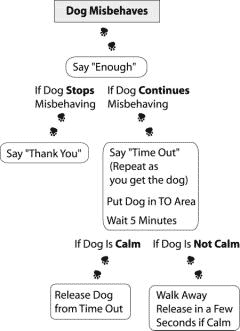Are you wondering how long you should put your dog in timeout? Well, look no further! In this article, we will explore the appropriate duration for putting your furry friend in timeout and provide some helpful tips on how to effectively utilize this disciplinary method. Whether your dog has been misbehaving or simply needs a short break, we’ve got you covered with all the information you need to ensure a harmonious living environment for both you and your lovable canine companion.
Understanding the Concept of Timeout for Dogs
What does timeout mean for dogs?
Timeout for dogs refers to a period of isolation or separation from a particular situation or individuals. It is a method used to address unwanted behaviors by giving the dog a chance to calm down and reflect on their actions. The purpose of timeout is to interrupt the behavior, allow the dog to reset, and prevent the reinforcement of undesirable actions.
Basics of applying timeout to dog’s behavior
When implementing timeout, it is important to remember a few key steps. Firstly, you must clearly communicate to your dog that their behavior is unacceptable. Use a firm and assertive tone to convey your disapproval. Next, promptly and calmly remove the dog from the situation and place them in a designated timeout area. This area should be quiet, without distractions, and preferably away from the rest of the family. Lastly, ensure that the duration of the timeout is appropriate for the dog’s age, breed, and the severity of the behavior. We will delve into this further later in the article.
Misconceptions about dog timeout
There are a few common misconceptions surrounding the concept of timeout for dogs. Some owners may believe that timeout is punishment or an act of revenge towards their pet. However, it is essential to understand that timeout is not meant to be a negative or vindictive experience for the dog. Instead, it serves as a method of redirection and correction, allowing the dog to learn proper behavior through self-reflection. Timeout should never involve physical harm or aggressive actions towards the dog.
Determining the Right Amount of Time for Timeout
Factors that can determine duration
The duration of timeout can vary depending on several factors. One such factor is the specific behavior you are addressing. For minor or nuisance behaviors, a shorter duration may be sufficient. However, for more severe or dangerous behaviors, a longer timeout may be necessary. Additionally, the individual dog’s temperament and response to timeout should be taken into consideration. Some dogs may quickly calm down and reflect on their actions, while others may require more time to reach a state of relaxation.
Role of the dog’s age and breed
Age and breed can also influence the appropriate length of timeout. Puppies and young dogs typically have shorter attention spans and may require shorter timeouts. As they mature and develop self-control, longer timeouts may be more effective. Furthermore, different dog breeds have varying energy levels and behavioral tendencies. High-energy breeds may need longer timeouts to fully dissipate their excess energy and regain their composure.
Considering the severity of the dog’s actions
The severity of the dog’s actions is a crucial factor in determining the duration of timeout. Minor infractions or small displays of improper behavior may only warrant a brief timeout to redirect the dog’s attention. However, if the dog engages in aggressive behaviors or poses a threat to themselves or others, a longer timeout may be necessary to ensure their safety and to reinforce the gravity of their actions.

Commonly Suggested Timeout Duration
General guidelines
While there is no one-size-fits-all answer to how long a dog should be put in timeout, general guidelines can be helpful. It is generally recommended to start with shorter timeouts, typically ranging from 30 seconds to a few minutes, for minor misbehaviors or instances where the dog needs a moment to calm down. For more significant actions or repeated behaviors, timeouts can be extended to a maximum of around 10-15 minutes. However, it is crucial to monitor the dog closely and consider their response to the timeout.
Duration recommended by dog trainers
Dog trainers often suggest tailoring the duration of timeout to the individual dog’s needs. They advise observing the dog’s behavior during the timeout and assessing whether they have calmed down and gained control over their emotions. This process can help determine the appropriate length for future timeouts. Trainers typically recommend starting with shorter durations and gradually increasing as necessary, always considering the dog’s wellbeing and response.
Opinions from animal behavior experts
There is a range of opinions among animal behavior experts regarding timeout duration. Some experts believe that shorter timeouts are more effective, as they allow the dog to quickly associate their timeout with the unwanted behavior. Others argue that longer timeouts can provide the dog with a more substantial period of reflection and calmness. Ultimately, it is essential to consider the individual dog and their unique needs when determining the ideal duration.
Implementing Timeout Correctly
Timing the punishment right after the wrong behavior
Timing is crucial when implementing timeout as a corrective measure. It is vital to address the behavior promptly after it occurs to ensure the dog can make the association between their actions and the consequence. Delaying the timeout may cause confusion in the dog’s mind, making it difficult for them to understand what they are being disciplined for.
Choosing the right location for timeout
Selecting an appropriate location for timeout is essential for its effectiveness. The chosen area should be secluded, quiet, and free from distractions. This will help the dog focus on calming down and reflecting on their behavior without additional stimulation. Avoid using areas where the dog typically feels comfortable or safe, as this may not provide the desired impact of timeout.
Returning your dog from timeout
After the designated timeout duration has elapsed, it is crucial to reintegrate your dog into the family or environment positively. Call them back to you using a calm and reassuring tone of voice, praising them for their improved behavior and displaying forgiveness. This reinforces the idea that the timeout was a temporary consequence and allows the dog to rejoin their social group with a fresh start.

The Effect of Timeout Duration on Your Dog’s Behavior
How timeout influences dog’s understanding of right and wrong
Timeout plays a significant role in shaping a dog’s understanding of acceptable and unacceptable behavior. By consistently applying timeout when inappropriate actions occur, dogs begin to associate those behaviors with the temporary isolation and negative consequences of timeout. Over time, this association helps them learn what is expected of them and encourages them to make more desirable choices.
Pros and cons of longer timeout durations
While longer timeouts may seem like a logical solution for more severe behaviors, they come with both advantages and disadvantages. Longer timeouts allow for a more extended period of reflection, potentially leading to a deeper understanding of the consequences of their actions. However, it is essential to consider the potential negative impact of extended isolation, as it may cause stress or anxiety in some dogs. Monitoring your dog’s response and adjusting the duration accordingly is crucial.
Research studies on dog behavior and timeout
Several research studies have examined the effects of timeout on dog behavior. One study published in the Journal of Applied Animal Welfare Science found that timeouts, when correctly implemented, reduced undesirable behaviors in dogs compared to other disciplinary methods. The study emphasized the importance of consistent enforcement and appropriate duration for optimal effectiveness. Additional research is necessary to further explore the long-term effects of timeout on dog behavior.
How Often Should You Put Your Dog in Timeout?
Identifying reasons for frequent timeouts
Frequent timeouts can indicate persistent unwanted behaviors or a failure to effectively communicate expectations to your dog. Identifying the underlying reasons for the repeated need for timeout is crucial in addressing the root cause of the problem. It is possible that these behaviors require more extensive training or behavioral interventions to correct.
Dealing with persistent unwanted behaviors
Persistent unwanted behaviors may require a more comprehensive approach than timeout alone. It may be beneficial to consult with a professional dog trainer or behaviorist who can assess the specific behaviors and provide targeted guidance and training techniques to address them effectively. Combining timeout with positive reinforcement and other training methods can lead to more successful outcomes in correcting persistent unwanted behaviors.
Balancing out with positive reinforcement
While timeout is an essential tool in correcting undesirable behaviors, it is essential to balance it with positive reinforcement for good behavior. Positive reinforcement involves rewarding your dog with treats, praise, or playtime when they engage in appropriate actions. By rewarding desired behaviors, you reinforce and encourage your dog to make better choices, making timeout less necessary over time.

Alternatives to Timeout
The use of positive reinforcement
Positive reinforcement is a powerful alternative to timeout and can be highly effective in shaping a dog’s behavior. By rewarding desired behaviors and ignoring or redirecting unwanted actions, you can help your dog understand what is expected of them. This method focuses on reinforcing desirable behaviors rather than solely relying on punishment or timeout.
Training methods to correct behavior
Various training methods can be employed to correct behavior without solely relying on timeout. One method is the “redirect and reward” technique, which involves redirecting your dog’s focus when they engage in unwanted behavior and rewarding them when they demonstrate appropriate actions instead. This method helps the dog associate positive outcomes with desirable behavior, making it more likely to occur in the future.
Leveraging professional dog training services
If you are facing difficulties in addressing your dog’s behavior through timeout or other training methods, seeking professional dog training services may be beneficial. Professional trainers have the expertise to assess your dog’s behavior, provide specialized training techniques, and guide you in effectively modifying their behavior. They can tailor the training to your dog’s individual needs and ensure a positive, consistent approach to behavior correction.
Common Mistakes When Putting Dogs in Timeout
Inconsistent application of timeout
One of the most common mistakes when using timeout as a corrective measure is inconsistency. It is essential to apply timeout consistently and ensure that all members of the household follow the same approach. Inconsistency can confuse the dog and diminish the effectiveness of timeout as a teaching tool. Consistent application reinforces the association between the unwanted behavior and its consequence.
Using timeout for the wrong reasons
Timeout should only be used for behaviors that are inappropriate, undesirable, or potentially harmful. Using timeout as a method to punish your dog for activities that are normal or instinctual may cause confusion and distress. It is crucial to differentiate between behaviors that need correction and those that require redirection or alternative training techniques.
Extending timeout too long
While longer timeouts may seem like a logical solution for more severe behaviors, it is important to strike a balance. Extending timeout excessively can cause heightened stress or anxiety in some dogs, potentially resulting in counterproductive outcomes. The duration of timeout should be appropriate for the specific behavior, the dog’s temperament, and their response to timeout.

Recognizing Signs of Stress or Anxiety from Timeout
Physical signs of distress in dogs
Timeout, if improperly implemented or excessively prolonged, can sometimes cause stress or anxiety in dogs. It is crucial to be attentive to physical signs of distress, such as excessive panting, trembling, pacing, or restlessness. These signs indicate that the dog may be experiencing heightened emotional states and may require alternative training methods or professional guidance.
Understanding dog’s emotional response to timeout
Dogs are social animals that thrive on companionship and interaction. Timeout temporarily removes them from their social group, which can trigger feelings of isolation or anxiety. It is important to consider the emotional response of your dog during timeout and adjust the duration and method as needed to minimize stress and promote their overall well-being.
Ways to alleviate stress or anxiety from timeout
If you notice signs of stress or anxiety during or after timeout, it is essential to address and alleviate these negative emotions promptly. Providing your dog with a safe and comfortable space, providing them with toys or treats, or engaging in positive interactions after the timeout can help alleviate stress and promote positive associations with the timeout experience.
Checking In with a Vet or Professional Trainer
When to consult a professional
If you are facing difficulties in implementing timeout effectively or are unsure about the best approach to address problematic behaviors, it is advisable to consult a professional dog trainer or behaviorist. They can assess your dog’s behavior, identify underlying causes, and develop a tailored training plan to address the issues you are facing. Additionally, if your dog shows unusual reactions or symptoms of distress during or after timeout, consult with a veterinarian to rule out any underlying health concerns.
Discussing the dog’s behavior with a vet
Your veterinarian can provide valuable insights and advice regarding your dog’s behavior. They can rule out any potential medical conditions that may contribute to the unwanted behaviors and recommend appropriate training or behavioral modification techniques. Discussing your concerns with a vet ensures that you take a comprehensive approach to your dog’s well-being.
Getting advice from a professional dog trainer
A professional dog trainer can offer guidance and expertise in effectively implementing timeout and other training methods. They can help you tailor the approach to your dog’s individual needs and provide insight into the most successful techniques for correcting unwanted behaviors. Professional trainers have experience working with dogs of all breeds and temperaments, making them a valuable resource for addressing behavioral issues.
In conclusion, timeout can be a useful tool in correcting unwanted behaviors in dogs when implemented correctly and in the appropriate circumstances. It is crucial to consider factors such as the behavior being addressed, the dog’s age and breed, and the severity of the actions when determining the duration of timeout. Consistency, positive reinforcement, and a comprehensive approach to behavior correction are key ingredients in achieving long-term success. Remember to always prioritize your dog’s well-being and consult professionals when necessary to ensure the most effective and humane approach to training and behavior modification.





Leave a Reply
You must be logged in to post a comment.